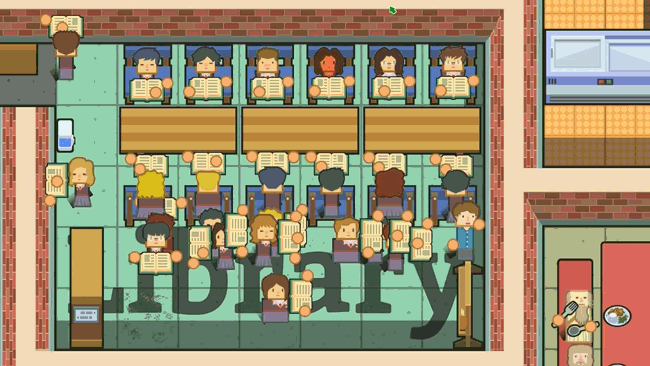Squeaky Wheel recently announced that the school management game Academia : School Simulator will soon be graduating out of Early Access. To help hype the announcement, I wanted to make two trailers, one for when we announce Version 1.0, and one for the actual release. The first trailer was released this week, which you can see above. Making game trailers is a key part of the marketing of a game, and there are many debates online about how to do it, how much it should cost, etc. I know that a lot of indie developers don’t really have a lot of money to spend on trailers, so I thought I would share my process here to give them an idea of what making their own trailer could look like.
Just to be clear, I know that this trailer is not the best, and it’s not going to compare to the best. But it is a pretty good trailer, made at a very affordable cost and with relatively little skill.
Conceptualization
The first step is to conceptualize the trailer. This means figuring out what you want to show in the trailer and making an outline of it that you can follow while actually editing the video. This is what my concept document looks like. I’ll reveal a bit of a cheat here. My original document was much looser than this, and I kinda went back and fixed it so that it looks as if it should if I was more disciplined.
You can keep it fairly simple or if you are artistically inclined and the concept is super complex you can even storyboard it. I’ve done it both ways. The important thing is to be able to get your ideas down so that you have some direction with the video. For this announcement video I wanted to keep it fairly simple. I used what Derek Lieu calls the music video montage as my template. Basically it means cutting a video in time with the background music. While this is usually better done with action games, you can make it work for more chill simulation games.
Finding the Music
Getting custom music done is great, but it can be creatively time consuming, especially if you don’t know what you want. I had a general idea of what I wanted, based on this trailer by Another Brick in the Mall. I wanted something that sounded classical and was also uplifting, with a relatively high bpm. Basically I was looking for lowkey excitement. I also wanted something that slowly builds up, then has a quiet release (sorry I don’t know how to speak music!) I also needed it to be around 1 minute long, which is the standard suggested length for a trailer.
After scouring numerous royalty free music websites I landed upon this track on soundstripe by Stephen Keech. It had everything I wanted, with the one exception that it was two minutes long. There was a section of the piece that ended a little after one minute though, so I decided to go for it and just fade the track out at the one minute mark to suit my needs. The license cost $39.95 for a single track. Soundstripe sometimes has promos where its good value for money to buy a year’s worth of access to licenses. I’ve already lined up a composer for the next trailer, so I was happy to take just the one track.
To edit the track to 1 minute, I used the free tool Audacity.
Recording Video Clips
Now that you have your music, it’s time to record video clips. Since I’ve already made a couple of trailers for our game before, I didn’t have to record all new material, and I was able to focus on recording some key clips. You can record video using OBS, or spend a little extra ($37) to download Fraps. Here are some broad tips for recording video clips:
High Res
Make sure that you have a lot of hard drive space and record the largest resolution that you can so it looks good on video.
Capture Movement
Whenever possible, try to capture movement in your game. A one minute trailer demands people’s attention, and there’s no easier way to do that than with movement. Even with a game like ours where there is not a lot of action, you can fake movement by panning and tracking the camera slowly to make players feel like there’s movement.
Hide UI
Depending on your game, it may be good to have a button where you can hide your UI.
Camera Controls
Add camera controls to your game like being able to set the speed of the camera scrolling, so you can choose if you want to emphasize speed (for excitement) or slow down the camera (for drama or visualization). Being able to lock the camera onto a scene is also helpful. I messed up a little bit in the video in the scenes where the workers are building the school because we didnt have this feature. It’s barely noticeable but annoyed me so much!
Image Editing
You will need at least basic image editing to create stuff like the logo and any sprites you may use for the trailer. I didn’t add the to the cost of the trailer because presumably if you are making a game you have all of these assets already, but just adding it here in case it needs to be said.
Video Editing Software
Next up is video editing! Adobe Premiere is the standard for video editing, but when I was cutting our previous trailer I found this neat software called PowerDirector. It does everything I need it to for the trailer and only costs $19.99 for one month or $48.99 for an entire year, which is like $4 a month for 12 months. Given that I wanted to make two trailers, it made total sense for me to get the annual subscription. But for your purposes you should be able to learn everything you need to know and release the trailer within the span of a month.
I can’t teach you how to use Powerdirector in one article, so the following part of the article presumes you already understand how to use video editing software in general. What I will try to explain is how to use transitions within a video to create moments that are pleasing to the viewer’s eye.
Opening Scene
For the opening scene I did a bit of a cheat. It’s drilled into every gamedev that you should NOT put your logo within the first few seconds of the trailer because nobody cares about your logo. I agree to a certain extent, but I think there is value in imprinting the name of your game on a viewer within the first few seconds, assuming you figure out a clever way to do it.
In my case my initial concept for the trailer opening was to have a bus slide in from the right and “drop off” some characters, who would then move offscreen to start “building” the school. This suggests the beginning of the school, and is capped off by the ending where a character walks home after a long school day. At some point before starting the trailer I realized I could slap on the Academia logo onto the side of the bus. It’s effective because it makes sense in the context of the universe. Buses often have logos stamped on their side. The logo will be in and out of the scene within 2 seconds, so it doesn’t overstay its welcome. But any player that watches the first 5 seconds of the trailer will at least remember that this game is called “Academia something or other”.
Jump Cuts and Building
Jump cuts are transitions where you simulate jumping forward in time. This is perfect for sections of the trailer where you show off building things. With each successive jump cut, showing off something “new” stimulates the viewer’s eye. This is particularly useful in building and management games because it really sells the idea of building something out of nothing, which is what attracts many players of this genre.
Transitions and Contrast
In art composition, contrast is one of the main techniques artist use to emphasize or highlight an artwork. It is the contrast between light and dark or warm and cool colors that helps an artwork visually “pop”. The same principle can be used in transitions. The first few scenes start out showing a zoomed in view and using jump cuts to sell the idea of “building”.
When the music transitions (more on that below) from a faster pace to a slower, more languid pace, I then transition to a zoomed out screen of a giant school, and slowly track the video upward. This matches the pace of the music, but more importantly it builds off the first few scenes where I show the building aspect of the game, to a scene that say “look at just HOW MUCH you can build!” It is the contrast between the smaller school zoomed in versus the giant zoomed out school that really sells the idea of the scale of the game.
Transitions and Music
Another easy way to capture viewers’ attention is by combining sound with transitions. This screenshot I took shows how I did that. Note that each transition (marked with an “A” Icon) is placed at the exact moment where there is the audio waveform increases in amplitude. When listening to the music, that increase is a thump of a percussion instrument. When that thump combines with a visual transition onscreen it triggers delight in a viewer’s pattern recognizing brain.
Off topic: when researching the right terminology for audio, I found this absolutely amazing interactive website explaining how waveforms work.
Wipe Transitions and Movement
I referenced the importance of finding some sort of movement to put in the trailer. We can combine this with the “wipe” transition to follow the camera movement and create a pleasing effect for the viewer’s eye.
Closing Scene
I had a moment of inspiration here while capturing video. My original intent was to simply fade the screen to black to signal the end of the day as a contrast and natural end point of the trailer which starts in the “morning”. However while capturing video for the trailer I noticed that it was nighttime and there was a single janitor on the way home from the school. I paused the game and zoomed in on this scene. It felt like the perfect way to end the trailer on a poignant note, everyone’s going home, the trailer is ending, development on the game will end. So I captured it and put it in the trailer. It’s important that even though you do a lot of planning in the conceptualization phase that you still be open to moments of serendipity like this.
Thanks for reading, and hope you found this interesting! If you want to support us, you can buy Academia: School Simulator , Political Animals, or Ruinarch.






